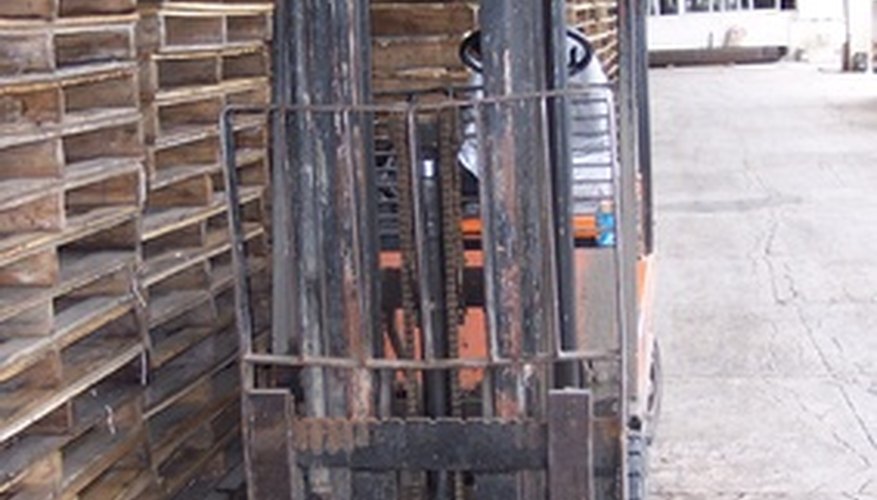Nissan uses its "K21" engine -- a 2.0-litre liquid-propane-gas- or gasoline-powered four-cylinder engine -- in a number of its LX-series forklifts. The LX is a fairly small hauler, designed to move palletised cargo weighing between 680 and 1361 Kilograms. The K21 is used only for forklifts rated at 1134 Kilogram and lower; heavier-duty variants get the 2.5-litre K25 or a 3.3-litre diesel.
Description and Applications
The K21 displaces 2,065cc (126 cubic inches). It comes with either a carburettor or electronic fuel injection (referred to in Nissan nomenclature as ECCS, or "electronic concentrated control system"). The carburetted K21 produces 46.23 horsepower at 2,200rpm and 116 pound-feet of torque at 1,600rpm. Fuel-injected K21s produce 60.1 horsepower at 2,700rpm and 118 pound-feet of torque at 2,000rpm. The K21 is used in L01A, PL01A, FL01A, UL02A and YL02A forklifts and all of their variants.
- The K21 displaces 2,065cc (126 cubic inches).
- The carburetted K21 produces 46.23 horsepower at 2,200rpm and 116 pound-feet of torque at 1,600rpm.
Basic Specs
All K21s have a 3.5-inch bore and 3.27-inch stroke, a two-valve cylinder head with bathtub-shaped combustion chambers, a 1-3-4-2 firing order (with the piston closest to the water pump being number 1). The K21 engine measures 28.85 inches long, 22.16 inches wide and 29.25 inches high; the engine weighs 138 Kilogram dry (without counting water in the cooling system or the four quarts of 10W-30 oil in its oil pan and filter). Compression ratio varies by fuel type: Gasoline-powered engines have 8.7-to-1 compression ratios and LPG engines have 9.3-to-1 compression ratios. Gasoline engines require 89 octane or greater; LPG engines require 30P or higher in colder seasons.
- All K21s have a 3.5-inch bore and 3.27-inch stroke, a two-valve cylinder head with bathtub-shaped combustion chambers, a 1-3-4-2 firing order (with the piston closest to the water pump being number 1).
Cam Timing Specs
All K21s, regardless of fuel type, use the same cam timing, idle and ignition settings. The intake valves open at 14 degrees before top-dead-centre (BTDC) and close at 30 degrees after bottom-dead-centre (ABDC); exhaust valves open 32 degrees before bottom-dead-centre (BBDC) and close 12 degrees after top-dead-centre (ATDC). There is 0.015 inch of clearance between the valve heads and the piston crown while the engine is hot.
Timing and RPM Specs
The K21 ignition comes stock with exactly zero advance or retard (zero degrees BTDC). Nissan sets the standard idle speed at 700rpm, but the K21 can idle at 2,700rpm when in high-idle mode. The K21 can run at 3,000rpm under continuous load; no-load rpm is governed at 3,600rpm. Power makes its way from the engine's crankshaft to the hydraulic pumps via a silent-drive chain.
- The K21 ignition comes stock with exactly zero advance or retard (zero degrees BTDC).
- The K21 can run at 3,000rpm under continuous load; no-load rpm is governed at 3,600rpm.
Speciality Tools
You'll need a number of speciality tools to service the K21, all of which are available through Nissan or your forklift dealer. They include a pulley puller (tool #KV11103000), an engine attachment (tool #ST05240001), an engine stand assembly (#ST0501S000), a crankshaft main bearing cap puller with two adaptors (#KV101041S0), a valve lifter (#ST12070000), a valve guide reamer set with 7.00mm reamer (#ST1102S000), an oxygen sensor socket (#KV10113700), a front and rear oil seal drift rod (#ST1524S000 and #KV10105500, respectively) and an oil seal drift rod (#ST15243000).
